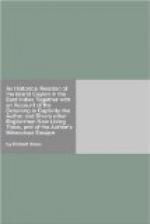[Tolla-guion.] But there is the Tolla guion very like the former, which is eaten, and reckoned excellent meat. The Chingulays say it is the best sort of flesh; and for this reason, That if you eat other flesh at the same time you eat of this, and have occasion to vomit, you will never vomit out this tho you vomit all the other. This creature eats not carrion, but only leaves and herbs; is less of size than the Kobbera guion, and blackish, lives in hollow Trees and holes in the Humbosses: And I suppose is the same with that which in the West Indies they call the Guiana.
[The People eat Rats.] This Countrey has its Vermin also. They have a sort of Rats, they call Musk-Rats, because they smell strong of Musk. These the Inhabitants do not eat of, but of all other sort of Rats they do.
Before I conclude my discourse of the Growth and Product of this Countrey, it will not be improper to reduce under this head its Precious Stones, Minerals, and other Commodities. Of which I shall briefly speak, and so make an end of this First Part.
[Precious Stones.] In this Island are several sorts of Precious Stones, which the King for his part has enough of, and so careth not to have more discovery made. For in certain places where they are known to be, are sharp Poles set up fixed in the ground, signifying, that none upon pain of being stuck and impaled upon those Poles, presume so much as to go that way; Also there are certain Rivers, out of which it is generally reported they do take Rubies and Saphires for the Kings use, and Cats eyes. And I have seen several pretty coloured stones, some as big as Cherry-stones, some as Buttons, and transparent, but understood not what they were. Rubies and Saphires I my self have seen here.
[Minerals and other Commodities.] Here is Iron and Christal in great plenty. Salt-Petre they can make. Brimstone some say, is here, but the King will not have it discovered. Steel they can make of their Iron. Ebony in great abundance, with choice of tall and large Timber. Cardamums, Jaggory, Rack, Oyl, black Lead, Turmeric, Salt, Rice, Bettel-Nuts, Musk, Wax, Pepper, Which last grows here very well, and might be in great plenty, if it had a Vend. And the peculiar Commodity of the Island, Cinnamon. Wild Cattel, and wild Honey in great plenty in the Woods; it lyes in holes or hollow Trees, free for any that will take the pains to get it. Elephants Teeth, and Cotton, of which there is good plenty, growing in their own Grounds, sufficient to make them good and strong cloth for their own use, and also to sell to the People of the Uplands, where Cotton is not so plenty. All these things the Land affords, and it might do it in much greater quantity, if the People were but laborious and industrious. But that they are not. For the Chingulays are Naturally, a people given to sloth and laziness: if they can but any ways live, they abhor to work; onely what their necessities force them to, they do, that is,




